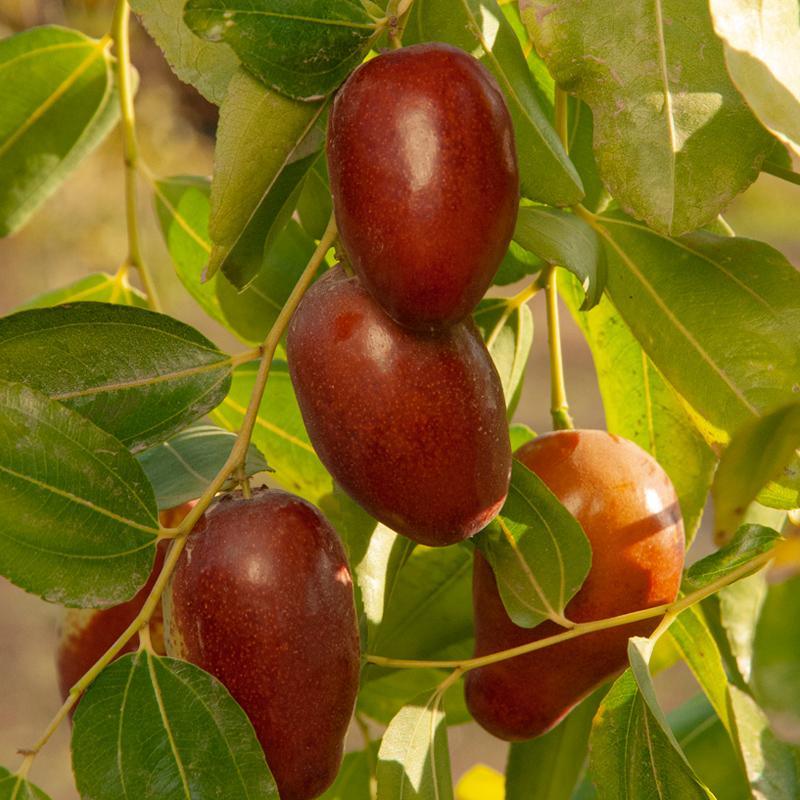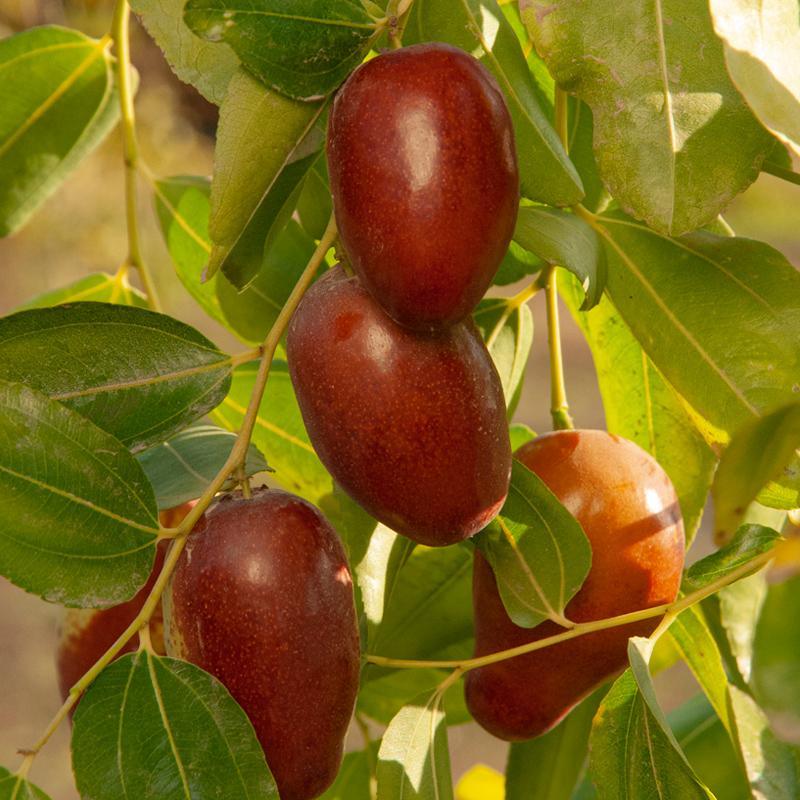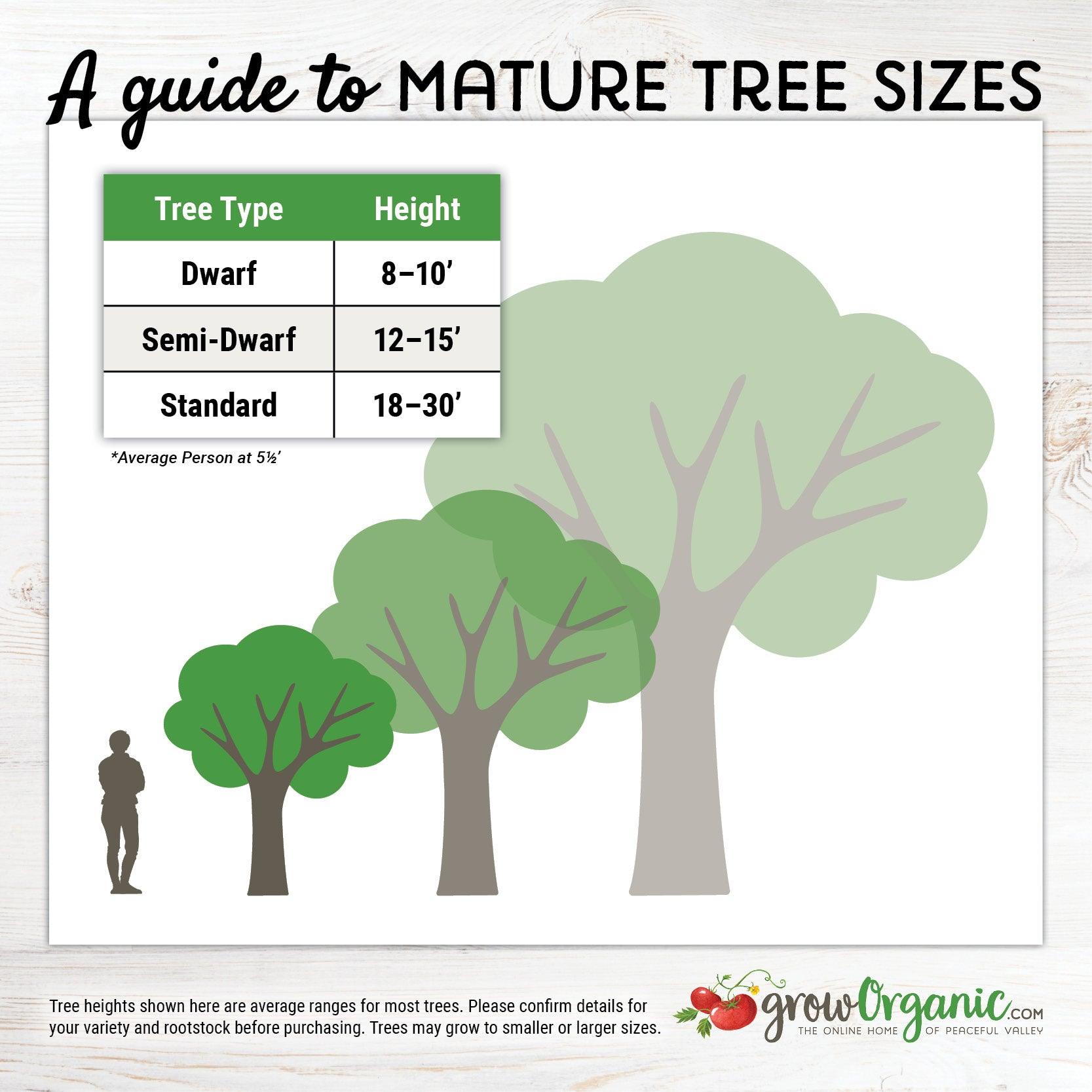Item Number: FT343
Jujube GA 866 Tree
Exceptional sweetness, high yields
GA 866 jujube trees are celebrated for their large, elongated fruit with dense, crisp flesh and exceptional sweetness. Known as one of the sweetest Chinese date varieties, GA 866 is perfect for fresh eating or drying into chewy, date-like snacks with a delightful date flavor. This partially self-fruitful variety benefits from planting near other jujube trees, such as Li or Lang, for increased fruit production. Thriving in full sun and well-draining soil, GA 866 is highly drought-tolerant and performs well in hot climates. With its vigorous growth, fine lacy foliage, and high yields, GA 866 is a favorite for both home gardeners and commercial orchards. Its rich flavor, excellent texture, and reliable productivity make it a premium choice for jujube enthusiasts.
on Jujube rootstock.
- Zones: 5-9
- Chill hours: 200
- Harvest: September 10 - October 20
- Looks: Two-inch elongated fruit is incredibly sweet with an apple-like flavor
- Personality: Elongated fruit
- Facts of note: Tree is precocious, hardy, drought resistant, virtually pest and disease free. Requires long, hot summer. Very low chill requirement.
- Pollination: Partly self-fruitful. Pollenized by any other jujube.
The Ga-866 JuJube tree, also known as Ziziphus jujuba, is a special fruit tree. It teaches us about ancient fruit cultivation methods. The tree provides insight into how people grew fruit in the past. Revered for its historical significance, unique fruit, and adaptability, the Ga-866 Jujube tree has found a special place in modern gardens.
Jujube trees, native to tropical regions, are increasingly cultivated in the United States for their abundant fruit production. Unlike citrus fruits commonly found in grocery stores, jujubes offer a unique flavor profile. They are renowned for their nutrition, as their fruit is high in vitamins and minerals.
These trees thrive in warmer climates and produce an abundance of small, sweet fruits, which can be enjoyed fresh or dried. With their rising popularity, jujube trees are becoming a favored addition to home gardens and orchards across the country.
Jujubes, also known as Chinese dates, are tropical fruit trees known for their prolific fruit production. These trees bear small, round fruits that resemble dates and offer a delightful sweetness. While they can be consumed fresh, jujubes are often enjoyed dried, resembling chewy candies with a unique flavor. Cross-pollination is key for optimal fruit production, encouraging the exchange of pollen between different varieties of jujube trees. With their ability to thrive in warm climates and produce bountiful harvests, jujube trees are becoming increasingly popular choices for home orchards and gardens.
Unveiling the Ga-866 Jujube Tree:
Origin: Jujube trees have a long history of cultivation dating back thousands of years, primarily in China. The Ga-866 variety reflects an ancient tradition, linking us to the past.
Size and Growth Habit: Ga-866 Jujube trees are typically small to medium-sized, making them suitable for both small and large gardens. They have a rounded and somewhat spreading growth habit, with an appealing canopy of shiny green leaves.
Fruit: The star attraction of the Ga-866 Jujube tree is its unique fruit. Jujubes are small, round or oblong, and often resemble dates. They start as green and turn brown when fully ripe. The fruit has a sweet and slightly tangy flavor, with a crisp, apple-like texture.
Adaptability: Ga-866 Jujube trees exhibit adaptability to a wide range of climates and soil types. They thrive in full sun and well-draining soil but can tolerate drought and less-than-ideal conditions.
Cultivating Ga-866 Jujube Trees:
Location: Plant Ga-866 Jujube tree in a sunny spot in garden with 6 hours of direct sunlight daily. Ensure that the soil drains well to prevent waterlogging.
Zone:The GA 866 Jujube Tree thrives in USDA zones 5-9, performing best in warmer climates with hot summer conditions and well-drained soil. This jujube variety, known for its sweet apple-like flavor and highest sugar contents, produces tasty fruit that can be eaten fresh or dried to resemble dates. While considered self-fertile, planting multiple trees or ensuring cross pollination can result in heavier crops, particularly during mid to late summer, leading to a bountiful harvest in early fall.
Chill Hours:The GA 866 Jujube requires approximately 200 chill hours to ensure optimal fruit production, making it well-suited for warmer climates in USDA zones 5-9. This jujube variety, known for its sweet apple-like flavor and crisp texture, thrives in well-drained soil with full sun. While considered self-fertile, planting multiple trees or encouraging cross pollination can result in heavier crops, with its reddish-brown fruit ripening from mid to late summer into early fall.
Sunlight:The GA 866 Jujube Tree thrives in full sun, a key factor for maximizing fruit production and achieving its signature sweet apple-like flavor and crisp texture. This jujube variety, known for its reddish-brown fruit that can be eaten fresh or dried to resemble dates, performs best in warmer climates with hot summer conditions. While considered self-fertile, planting multiple trees or encouraging cross pollination enhances the yield of this great variety, ensuring abundant tasty fruit from mid to late summer into early fall.
Planting: Plant your Ga-866 Jujube tree in the spring, ensuring there is 15-20 feet of space between multiple trees for good growth and air circulation. Dig a hole slightly larger than the root ball, and water thoroughly after planting.
Pruning: Pruning your jujube tree can help shape it, promote healthy growth, and improve fruit production. Prune in late winter or early spring when the tree is dormant.
Watering: Jujube trees are drought-tolerant once established, but regular watering during the first few years is essential for healthy root development. Deep watering less often is preferable to shallow, frequent watering.
Fertilization: Ga-866 Jujube trees benefit from a balanced, slow-release fertilizer in the spring. However, avoid excessive nitrogen, as it can lead to excessive vegetative growth at the expense of fruit production.
Harvesting and Culinary Uses:
Harvesting: Ga-866 Jujubes are typically ready for harvest in late summer to early fall. You can tell they are ripe when they turn brown, feel slightly wrinkled, and have a sweet aroma. They should have a crispy texture, similar to apples.
Fresh Consumption: Fresh Ga-866 Jujubes are delightful to eat as a snack or incorporated into salads and desserts. Their sweet and slightly tangy flavor makes them a unique addition to your fruit repertoire.
Drying: Jujubes are often dried, similar to dates, which intensifies their sweetness and extends their shelf life. Dried jujubes can be used in various culinary creations, including trail mixes and baked goods.
Jujube Tea: In some cultures, jujubes are used to make a soothing and flavorful tea. Simply steep dried jujubes in hot water for a calming and fragrant beverage.
The Ga-866 Jujube tree brings the rich history and unique flavors of ancient fruit cultivation to modern gardens. With its adaptability, attractive appearance, and delicious fruit, this tree is an excellent choice for both experienced and novice gardeners. Whether you enjoy the jujubes fresh, dried, or as a tea, the Ga-866 Jujube tree promises a delightful culinary journey while connecting you to the roots of horticultural history.
Why Buy GA 866 Jujube Tree From Us?
The GA 866 Jujube Tree thrives in full sun, a key factor for maximizing fruit production and achieving its signature sweet apple-like flavor and crisp texture. This jujube variety, known for its reddish-brown fruit that can be eaten fresh or dried to resemble dates, performs best in warmer climates with hot summer conditions. While considered self-fertile, planting multiple trees or encouraging cross pollination enhances the yield of this great variety, ensuring abundant tasty fruit from mid to late summer into early fall.
Visit our Fruit Tree Central for a listing of all our fruit tree videos and articles.
Visit Tree Characteristics for a listing of all our fruit & nut tree growing characteristics.
For more information about different types of rootstocks and how they influence tree size and growth, see our Tree Rootstock Characteristics Chart.



Check Your Zone Compatibility:
Compatible with your zone.
Growing Zone for

Our Guarantee To You
Since 1976, we've served our customers at every stage of growing. Please contact us at any time. We are happy to support and assist you.
Shipping Information
Shipping Information
Cannot ship to the following states: HI, AK, PR, GU, VI
Shipping Weight: 5.0 lb
Dimensions: 47.5"L x 7.3"W x 2.75"H
Features
Features
- Bare Root
- Suited to Warmer Climates
Characteristics
Characteristics
Planting & Care
Planting & Care
Useful Information
Useful Information
Guarantee
Guarantee
Limited Dormant Tree & Plant Guarantee
* Claim deadline is June 15th
We guarantee that your dormant tree or plant will arrive in good, viable condition. If your tree arrives in substandard condition, notify us within 3 days of delivery. Please email pictures of the box, inside packaging, the tree and its roots to helpdesk@groworganic.com. We will investigate your claim and process a request to exchange or refund the damaged product.
If your dormant tree or plant has not grown new leaves by June 15th, you may be eligible for our Limited Dormant Tree & Plant Guarantee. This guarantee provides for a store credit for the purchase price of the tree, excluding shipping. Please see the Instructions below.
Important Dates:
- April 1st Dormant trees/plants must be planted in the ground
- May 15th Perform scratch test, if no new leaves have grown
- June 15th Deadline to apply for a dormant tree/plant credit
All required documentation must be received by June 15th for your claim to be considered. Claims or documentation received after June 15th will be denied, without exception. Instructions listed below
Terms and Conditions
We cannot guarantee that your tree or plant will remain alive and healthy after it is received, or bear fruit as there are too many variables in your environment that are beyond our control (i.e. soil preparation, weed and pest control, proper irrigation, chill hours, compatible hardiness for your growing zone, proper choice of pollinator, extreme weather, rodent damage, disease, etc.).
We cannot guarantee that we will be able to provide a replacement tree/plant of the same species either that same growing season or in future years. Customers are responsible for all shipping fees associated with replacement trees and plants.
If we determine that the tree you purchased directly from us is not viable, we will issue you a store credit (not a refund) for the purchase price of the affected dormant tree or plant. Shipping is not included in the dormant tree/plant guarantee. Store credits can be used to purchase any product we sell and are valid for use only until July 1st of the following year.
Historically, 98% of our dormant trees and plants grow and thrive when they have been cared for and planted using our growing guides. Dormant trees and plants must be planted in the ground by April 1st in order to be eligible for credit. If the ground in your area is still frozen solid, you may temporarily plant your tree or plant in a pot.
Potted, non-dormant trees or plants are excluded from this guarantee as they are not dormant at the time of shipment. Evergreen trees such as citrus, avocado and olive trees are not available for credit under the Dormant Tree and Plant Guarantee.
Instructions
We guarantee that your dormant fruit tree or plant will leaf out, if you care for it according to our growing guides. In the unlikely event that your dormant tree or plant does not have leaves by May 15th, follow these simple steps to apply for a store credit:
Before you call or email, please perform a “scratch test” to determine if the tree or plant is still alive. This video shows how to check for live tissue under the bark. Scratch tests need to be done a few inches above and below the graft.
Green Cambium Layer / Living Trees
If the cambium layer under the bark is green, give your tree a little more time. It is still alive, but hasn’t come out of dormancy yet. Check to make sure that it is getting the right amount of deep root water, enough sunlight and that the weather is warm enough for that type of tree/plant to come out of dormancy. Every tree has its own personality and will come out of dormancy at different times. Be sure to submit the required documentation listed below by June 15th, if it doesn’t grow leaves.
Brown Cambium Layer / Dead Trees
If the scratch test shows a brown cambium layer or if your dormant tree/plant doesn’t have leaves by June 1st, please email us at helpdesk@groworganic.com. All required documentation listed below must be received by June 15th for your claim to be considered. To be considered for the guarantee claim, all required documentation must be received by June 15th. Incomplete submissions will be denied.
Required Documentation
- Order number
- Name of dormant tree/plant and the quantity affected
- Photos of each tree or plant showing:
- The roots (tree or plant must be pulled out of the ground)
- The scratch test areas
- The entire tree/plant
We reserve the right to not issue credit for items that have already been replaced. We also reserve the right to require photographic evidence that the tree/plant was not killed by root rot, rodent or mechanical damage.
Share




Bought a small Jujube GA866 tree, it came in good package. I planned it the next day after received,. Now one month passed, the Jujube sprouted nicely. I am really happy.





